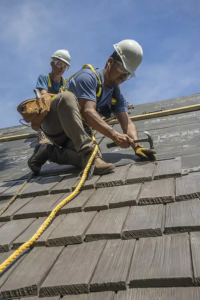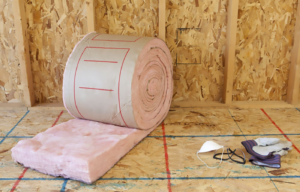The roof is one of the most critical elements of any building structure. It shields against harsh weather and significantly impacts a property’s energy efficiency and aesthetic.
A roof comes in a variety of materials and finishes, from affordable asphalt shingles to more expensive composition or slate tiles. The choice is yours, but it’s important to understand the basics of roofing before making a decision. Click the https://www.roofersincolumbusga.com/ to learn more.

Plywood is a popular choice for sheathing and roofing due to its strength, durability, and resistance to environmental conditions. The plywood manufacturing process is meticulous – from selecting logs to slicing veneers, every step contributes to the quality of the finished product. Plywood is available in different forms, each with unique characteristics and applications.
Plywood manufacturers bind wood fibre sheets together with resin to create the material. The layers, also known as plies, are oriented at different angles, which increases their strength and resistance to bending. This allows plywood to be used in structural applications such as joists, shear walls, and fabricated beams. It can also be used in gussets and portal frames, as well as bracing panels and wall shears.
All types of plywood are durable, but some are better suited to certain projects than others. For example, grade A plywood has a smooth surface and minimal defects, making it ideal for projects where appearance is important. It can also be painted or stained for a high-end finish.
OSB, or Oriented Strand Board, is a similar product that has gained popularity in construction due to its superior strength and versatility. It’s made of wood strands that are mixed with resin and bonded together into thick sheets — a technique that makes it more resistant to warping or shrinking than traditional plywood. It’s also available in a range of thicknesses, making it an ideal choice for subflooring, sheathing, and other building applications.
Oriented Strand Board (OSB)
Oriented strand board (OSB) is an engineered wood panel that is a substitute for plywood in sheathing applications. It is manufactured using strands of low-density wood from small diameter trees, such as poplar, which can be harvested and grown more quickly than the large diameter, old-growth wood used in plywood. The strands are bonded together with industrial adhesives and cured under heat and pressure to form the OSB panels, which can be used in traditional platform-frame construction, multifamily housing, and nonresidential buildings.
Like other wooden products, OSB can be subject to biological deterioration by moisture and molds. To combat this, OSB is treated with fungicides and/or fungicide preservatives such as zinc borate and oxine copper, which are sprayed on the surface of the boards to help resist the growth of biological organisms that cause rot or decay.
The structural performance of oriented strand board is similar to that of plywood, and it is often used in place of it in floor, wall, and roof sheathing. It is also frequently used in framing wood I-joists and for manufacturing other engineered wood products, such as wood I-beams. Oriented strand board is produced in mats that are 6- to 8-feet wide and can be cut into lengths according to project needs.
Unlike plywood, oriented strand board is made with water-resistant glues and a protective wax coating, which helps protect it from damage and decay during transport and installation. It is not recommended to install OSB in areas that will be exposed to direct rain, but brief periods of exposure should not present a problem.
Metal Substrates
When it comes to choosing metal panels for roofing, aesthetics are a key consideration. But picking the right substrates and coatings is equally important when life expectancy and long-term performance are key. In this blog post, Alpine Roofing Construction shares some helpful tips to help you choose the best metal roof substrates for your project.
Roof substrates serve several purposes in metal roofing projects, including providing a solid base for fasteners and clips, securing non-structural style panels, and bearing the weight load from any debris or mounted structures. In addition, roof substrates can improve the acoustic performance of a building by reducing noise transmission.
The most common roofing substrates are wood, such as plywood and Oriented Strand Board (OSB). However, other types of materials can also be used as a roof substrate, such as concrete and steel. Metal substrates are becoming increasingly popular as they offer superior strength and durability, while allowing for a more lightweight and versatile roofing system.
The type of metal substrate you select will depend on the building’s environment and location. For example, galvanized substrates are a good choice for coastal areas, while bare copper is ideal for cold climates. When selecting a substrate, it’s important to keep in mind that certain metals will react with each other. This can lead to early degradation or staining of the metal panels. Therefore, it’s crucial to avoid combining different metals in the same roof system.
Underlayment
Underlayment provides an additional layer of protection to prevent moisture infiltration and enhance a home’s overall durability. Without underlayment, water can seep through a roof deck and cause problems like mold, mildew, and rot. In addition, the material protects against heavy rains and winds, helps stabilize the roof structure, and seals around flashing.
The type of underlayment you choose depends on the roofing system and your local climate conditions. Three primary options include asphalt-saturated felt, rubberized asphalt, and synthetic underlayment. Asphalt-saturated felt underlayment offers good water resistance but is not waterproof, making it best suited for roof slopes that are steep enough to allow water to drain quickly.
Synthetic underlayment is an option that offers superior tear resistance, durability, and slip-resistance even when wet. Higher-quality products also feature coarse or scrim-woven material reinforcement for added stability and strength.
For areas that experience extreme weather conditions, rubberized asphalt underlayment may be an appropriate choice. It is highly flexible and offers excellent UV resistance, which may help extend the life of your roofing materials. Ice barrier underlayment is another option to consider for areas that are prone to ice dams, which can form along the eaves and lead to water back-up underneath the shingles. Self-adhered underlayments can be a fast and easy way to protect these problem areas, as they require no mechanical fasteners and bond well with the surface of the roof deck.
Shingles
Shingles protect your home from the elements that would otherwise erode your roof, such as wind, rain and snow. They work in conjunction with other roofing materials to keep your house dry, including trusses, joists and roof decking.
The main components of shingles include ceramic granules (ground rock particles coated with colored, ceramic oxide), lap granules (coal slag ground to roughly the same size as the ceramic granules) and backsurfacer sand. Depending on the type of shingle, other additives can be used, such as talc, asphalt cement and asbestos.
Many shingle types are available, each with its own unique aesthetic and price point. The three main categories of shingles are single-layer 3-tab shingles, architectural shingles and luxury shingles.
3-tab shingles are the most affordable of the three, and have a distinct, uniform appearance. They typically last 15 years under normal conditions.
Architectural shingles have a dimensional look and can be arranged in different patterns to create a more custom aesthetic. They are also rated as “cool roof technology” due to their ability to reflect the sun’s damaging UV rays and reduce the amount of heat transferred to the home.
Luxury shingles offer the best blend of aesthetics and durability, but are more expensive than the other two categories. They are available in a variety of colors and are highly customizable to match your home’s architectural style. Each shingle type has its own unique coloration, texture and thickness, allowing homeowners to select the perfect look for their home.
Drainage
Drainage is the system of components and design elements that are used to remove water from a roof and convey it away from a building. Effective roof drainage prevents leaks, roofing material deterioration, damage to building foundations and other structural damage. It also helps to avoid ponding water, which can cause serious damage to almost all roofing materials over time.
Typical roofing systems include gutters, downspouts and scuppers. These work together to channel water from the roof to a discharge location, such as a storm drain or the ground. The roof surface is typically sloped to allow rainwater to flow down to low points on the roof, where the roof drains can be located.
Roof drains are typically either gravity or siphonic in nature. Gravity drains rely on the natural, albeit slight, roof slope to direct standing water towards the drain. The siphonic drain system uses vacuum pressure to collect and redirect the water flow. The most important thing to remember is that your roof drains should be regularly cleaned to avoid clogging, which can happen when debris such as leaves, pine needles and garbage enters the system.
Internal drainage piping is often made of PVC, but it can also be constructed from polypropylene or ABS (acrylonitrile butadiene styrene). While the latter two are more expensive, they perform better in sunlight and are less likely to burn in a fire.


